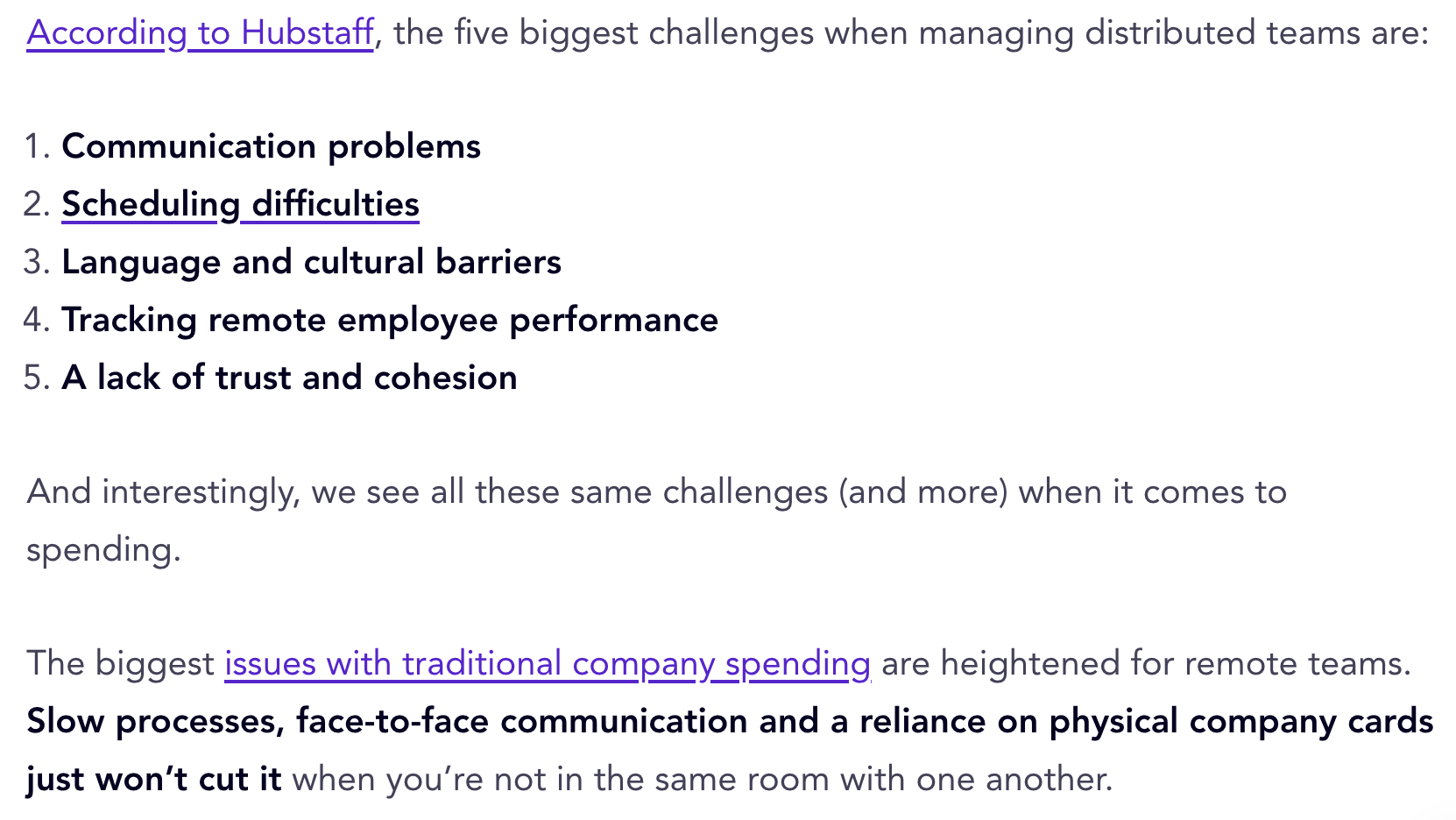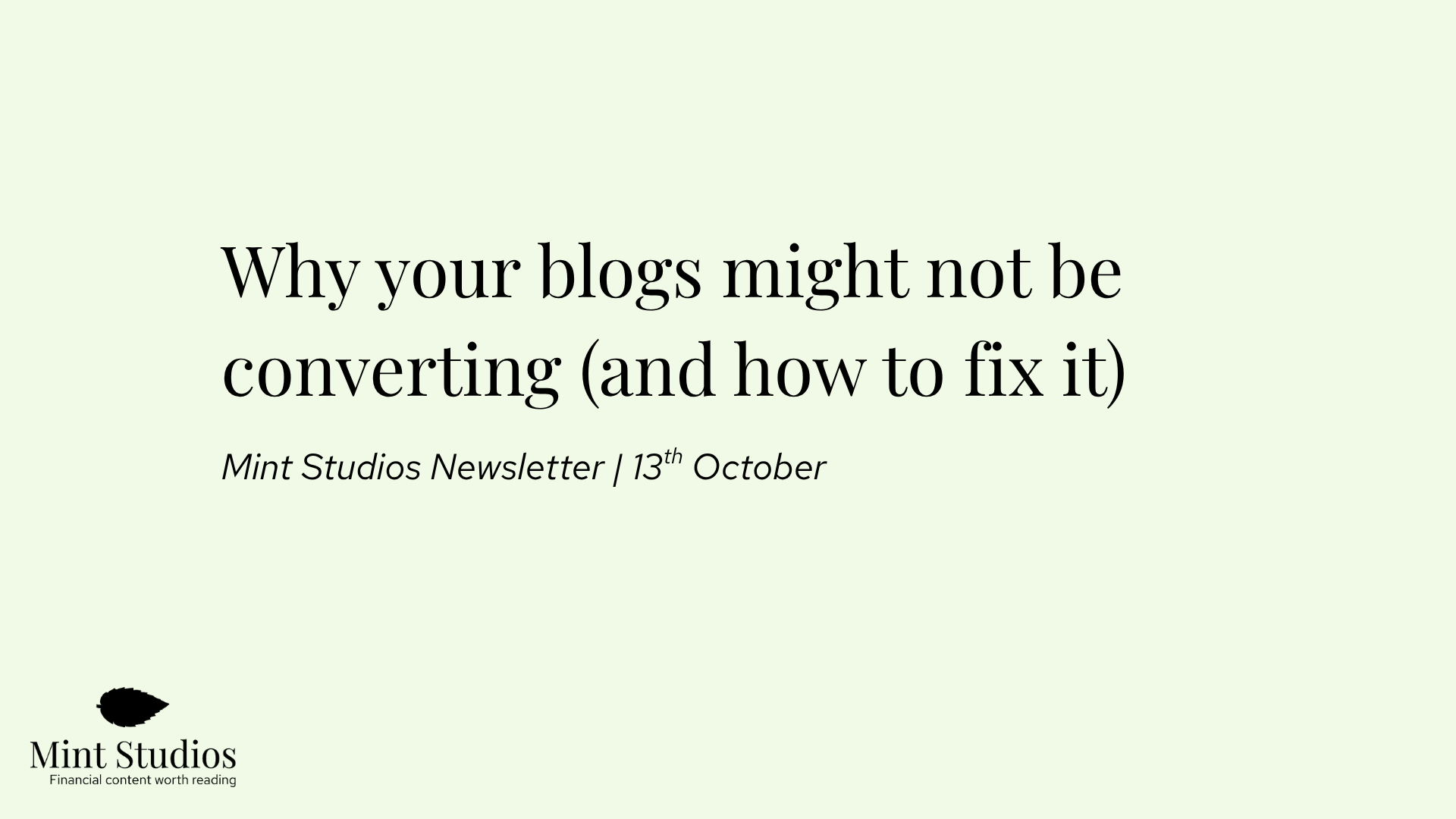We’ve written many times on our blog how difficult it is to find good written content online. We believe the main reasons it’s difficult is because:
- Most content is written for the wrong reasons.
- Writers aren’t aware of the readers’ pain points.
- Writing online is different to writing a novel or dissertation.
- Writing well is thinking well (and the writer has to care).
A lot of writing well comes down to hiring the right people, which is a process in itself (and we go into more detail later on). But even if you hire the right person, content can fall flat if the writer is not aligned with the reader’s pain points.
In this article, we’ll dive into why not understanding the readers’ pain points leads to bad content, and some tips on how to work with a writer to ensure your content speaks to your customers’ pain points.
Note: stay up to date whenever we publish a new article by joining our newsletter!
Why a lot of online content is bad: the writer doesn’t understand reader pain points
We believe that one of the main reasons a lot of online writing isn’t great is because the writer doesn’t understand who they’re writing for. This is often not the writer’s fault: the marketer who provides the “content brief” often doesn’t provide enough information about the target audience, and the writer is rarely involved in the strategy themselves.
This is how you can have incredible writers write something that doesn’t resonate with anyone. No matter how great a writer is, if they don’t understand who they’re writing for, the content won’t achieve its purpose.
Too often, content creation is outsourced to a writer who won’t know the intricacies of the product, market or customer they’re targeting. Again, it’s very hard to write a compelling piece if you don’t know who you’re writing for.
Not understanding the reader’s pain points is a huge problem because it leads to a few problems:
1. The content includes pain points that are not relevant
In trying to write something compelling, writers will often write about specific pain points that they think are relevant to the reader. But it’s not good enough to just include any pain points. They have to be specific to your ideal customer, the person you want to target. If not, you end up with a situation where the content focuses on the wrong pain points and value propositions that are not relevant for the reader.
Take this example. It’s a Spendesk article that’s about “how to manage company spending for remote teams”:

You can see here that Spendesk decides to refer to a third party to list the biggest challenges when it comes to managing distributed teams. Also, the challenges they list are fairly obvious and vague, like “communication problems”.
By referring to a third party to list their challenges, Spendesk loses credibility in the eye of the reader. How can Spendesk not know what the pain points are about managing remote spending? Isn’t this one of the key pain points their product solves for? The pain points are so vague that they are not relevant at all for the reader.
Instead, the writer could list pain points that are specific and relevant, such as:
- Lack of visibility leads to frequent overspending.
- Dealing with foreign remote spending is complex, costly and time consuming.
- Tracking and accounting for remote employee spending is difficult because it’s dispersive.
We’re able to write the above because we also wrote an article on this topic based on an interview with someone who understood customer pain points inside out. The Spendesk writer wasn’t able to do that because they likely didn’t know who they were targeting and what their issues were.
2. The content focuses on the wrong value props
If you don’t understand what your customer pain points are, then it’s very hard to know which specific value propositions (the features/benefits they care about) are worth including.
For example, take the keyphrase “sole trader accounting software”. Type this into Google, click on the first few results and read the articles. You’ll see that most of them are comparing different accounting software solutions. They also list key features:


It’s interesting to see the key features that the article includes about each product. As you can see, they seem to focus on highlighting the number of plans they offer, and how each solution will grow with you.
Based on our experience working with a fintech company that targeted freelancers, these two features are rarely a priority for freelancers. Few freelancers will be issuing 100+ invoices per month, and as a one person business it’s unlikely they’ll hire additional employees.
It’s a missed opportunity since there are value props that we know are very important to freelancers that they would want more information on. We would say the key ones for freelancers looking for an accounting system is:
- A tool that is quick to set up and learn how to use
- A tool that is affordable
- A tool that makes it easy to do their taxes
By not focusing on the right value props (because the writer might not understand the reader’s pain points), the reader skims through the piece and leaves knowing no more than before. They still don’t know if these solutions can help them solve their specific problems.
3. The content is full of fluff and vague language
Usually, writers write fluff when they don’t know what else to write up and aren’t clear on who the customer they’re targeting is and their pain points. We’ve all been there, and again, it’s usually because the writer hasn’t been given the resources to understand the customer.
There are too many examples of this type of writing on the internet, but here’s one from the same Spendesk article from above:

These two sentences don’t add anything to the article. Are the common issues with going remote predictable? And if so, why is that important to share? And how do daily habits become more complicated? Sure, they might be trying to set the scene, but this is an article for educating and attracting users, not entertaining. It’s not necessary.
Fluff and vague language indicates to the reader that you don’t actually know what you’re writing about and are writing to fill the page. To them, it’s a sign that your content is not worth reading and they’ll likely go somewhere else to get their information.
How to align your writer with customer pain points
So how do you align a writer with your ideal customer or reader and their pain points? Is it as easy as adding the pain points on your content brief when you send it to them?
Unfortunately, no. Far from it. There’s a lot more that goes into truly understanding your customer.
The following tips are specifically for content that is targeting your customers, with a specific purpose to raise brand awareness, position you as a thought leader and/or acquire customers. If you’re looking to write content to educate anyone interested in the topic (rather than your ideal customer), these tips may not be relevant.
Based on our experience training tens of writers and writing hundreds of articles that have brought in $500k+ in revenue for clients, here’s how we’ve learnt to align writers with the reader/ideal customer’s pain points.
1. Invest in educating the writer
First of all, you will have to invest in educating the writer on:
- Your product
- Your ideal customer
- The market
There are no shortcuts. Anyone who reads or writes a lot knows this: writing well is hard. You cannot hire a writer and expect them to write great content immediately. You need to invest in training your writer. If you’re going to work with a freelancer, then you want to make sure expectations and the fee is set to include this investment.
Let’s go through each of the three investments you’ll have to do:
To educate a writer on your product, you can:
- Do a product demo with them and show them how your product works.
- Share product documentation with them.
- Get them on a one on one call with a product person to explain the product.
To educate them on your ideal customer, you can:
- Share customer success calls or interviews with the customer.
- Get them on a one on one call with a salesperson where they ask questions about the customer.
- Share emails/sales enablement docs with them.
To educate them on the market, you can:
- Share resources in your market (e.g. if it’s payments, share payment publications, podcasts, etc with them)
When we do this it usually takes a month and we do it at the beginning of an engagement with a client. Since we’ve done this 10+ times across different products, we know which questions to ask, which resources and information to gather to ensure we get a good understanding of the product. Being fintech-only also speeds this up.
The number one thing that we’ve found helps with learning about product, customer and market, however, is constant feedback. In order for the content to be as aligned with your product, customer and market, you need someone to review the content and make sure it’s right.
What’s important here is that the writer needs factual edits, not style edits. That means that to make sure they get product features and pain points right, you need a product or salesperson who’s happy to review and make sure the information is correct. They don’t need to check grammar or spelling – that’s for the marketing department. Constant feedback and comments from experts will help a writer quickly get reader pain points right.
2. Create content based on interviews, rather than research
As long time readers of Mint Studios will know, 90% of the content we create for customers is based on interviews. This allows us to get unique information from the internal experts at the company that we couldn’t get anywhere else.
There is an added benefit: we can ask the expert about what they think the customer pain points are. When we begin an interview with an expert, we like to start with two key questions:
- Who do you think would be doing research on this topic?
- What are their pain points and challenges?
These two key questions at the beginning (which the writer will hear in the recording), gives us an expert’s perspective on the person we’re targeting. This helps a lot with understanding who we’re targeting and what their problems are.
In the Spendesk article above, it’s clear the writer didn’t know what the customer challenges are and had to do their own research. Quoting Hubstaff may sound very pro, but it’s obvious they got these pain points via searching online rather than real customer pain point knowledge.
Creating content based on interviews with experts helps us avoid a lot of the common issues with most content, and we highly recommend it to other content marketers and writers. It ensures that none of the content we create is copycat, generic content, and it means what we write has a genuine expert point of view. Most importantly, it means we can ask the people who do understand the ideal customer, what they think the pain points are.
When the writer writes the piece, they do it based on a recording with the expert. When the expert shares what they think the pain points are, it helps the reader understand who they’re targeting.
Read more: Why You Should Create Content Based on Interviews With Experts
3. Get the writer more involved in the content strategy
The writing process usually goes like this: the strategist puts together a “content brief”, sends it to the writer who then might do an outline, followed by the first draft, a review, and a second draft.
That works when you’re perhaps writing shorter articles that don’t go deep on customer pain points or the product. But when you’re doing content for customer acquisition or with a strategic purpose, this method fails for one simple reason: the writer is not involved in the strategy. They are not involved in choosing the topic, the audience or the angle.
You may argue: but the writer’s job is to write, not decide the strategy. That’s true, but writing and strategy go hand in hand. It’s very hard to write a good piece if you don’t know who you’re writing for, why and what their problems are. A journalist always knows who they’re writing for, and so does a novelist. It’s an inherent part of writing.
But at no point in the usual process above does the strategist double check that the writer understands the pain points.
Based on our experience you cannot force a writer to understand customer pain points. Including the pain points in the brief isn’t enough. You need the writer to come up with the pain points themselves.
You may like: Are Content Briefs the Spawn of Satan?
That’s why at Mint Studios we don’t use content briefs at all. Instead, we use a process inspired by Grow and Convert, which is the following:
Interview with the expert is complete and sent to the writer
- Writer fills in a “questionnaire” based on their own research and the interview
- Strategist reviews the questionnaire
- Writer writes first draft
- Strategist reviews
- Writer writes second draft
- Strategist reviews, checks for SEO and sends to client for review
The writer is still doing the writing and is not in charge of the strategy or content ideas. The key difference is that they are asked to fill in the “content brief” rather than the strategist. They are asked to come up with ideas on who to target, what their pain points are and which features and benefits to focus on.
What is in the questionnaire? We use two different ones: one for Bottom of the Funnel articles that are designed to convert, and another one for “story” articles that are designed to tell a story (more like thought leadership).
For BOFU ones, some of the sections include answering questions like.
- What do you think the target customer is looking for when they’re researching this?
- How will we make this piece better than what’s currently ranking?
- What was the customer doing before they found the product? What were their pain points? And how does the product solve these pain points?
- What features and benefits should we include?
- Outline the article
And a few other sections as well. You can get the full questionnaire template we use in your email below! 👇
Since the writer is the one who comes up with answers to these sections, it’s a lot easier to see if they understand the customer pain points or not. If they don’t, the strategist can come in and help out. The strategist and writer are a team: they’re both trying to figure out the pain points and right features and benefits to focus on. Instead of a top-down approach, it’s a more collaborative approach.
There are a few other things we do as well:
- We keep a working document with features and benefits of the product (because often we’re repeating them)
- We use Trello to keep track of things, due dates updating automatically
- We’re experimenting with adding a style editor in the process so they can ensure the articles matches TOV, etc
All of our articles use this process, and this is what has allowed us to create articles like this:
- Direct Debit API: How to set one up (and when to use one)
- 3DS2: Everything you need to know and how to prepare for it
- Corporate Expense Cards: How To Boost Your Purchasing Power in 2023
- How To Get Health Insurance As An Expat In The Philippines
In other words, articles that readers feel that they understand their pain points, and adequately explains their problems. Combine this with ranking on Google for the right keyphrases, and that’s how we get into a situation where we’re able to use content to help our clients bring in six figure customers.
Read more: Case Study: How We Helped Zai Gain Multiple SQLs Per Month with Content
4. Commit to training your writers
Even after having spent one month learning about the product, market and customer, and having a very comprehensive writing process, we’ve found that it’s often still not enough. Even then, the writing can fall flat.
And that’s because a lot hinges on the writing skill of the writer.
Writing for people who read online requires a particular set of skills. As you’ve seen in the very first section of this article, a lot of writers don’t know how to write content that is easy to read. In other words, content that is formal, to the point, easy to understand and specific. This is an entire other problem that affects humans as a whole: it’s hard to write well.
It’s very rare to find someone who writes well immediately – usually these are people in demanding, leadership positions, such as well-known journalists, CEOs and newsletters with thousands of readers. Writing well goes hand in hand with thinking well, and those who think well often end up doing something else than writing.
Since we’re never able to hire people who’ve reached that level (and it’s unlikely you would as well), we usually have to hire for potential and then train them. We have a very comprehensive process to hire writers. When we’re hiring, we look for signs that they could be a strong writer in their portfolio and we also pay them to complete a test. We also never expect them to be great immediately, we understand that it will take time and a lot of training.
When we hire a new writer, it usually takes around 3 months to train them to write in the style we’re looking for. This training involves teaching them skills like how to write about a product, how to minimize fluff and how to adequately explain features and benefits. We teach them how to write in a way that educates and builds trust, while also bringing in customers and ranking on Google. It’s a very unique combination of skills which we’ve never found in the wild, so we need to train them.
And if you want a writer who can write in detail about your product, market and customers, you’ll need to train them as well.
We won’t go into detail about how to do that, as the content would be enough to write a book. Instead, this section is more for awareness: be aware that it could take a minimum of 3 months before the writer reaches the level you want them to be at. For this reason it’s incredibly important to have a thorough vetting process, so you don’t waste months working with writers who aren’t a good fit.
Should you hire an in-house writer, a freelance writer or an agency?
A big reason a lot of writing falls flat is because it is productized and outsourced. People think “oh, I’ll hire a freelance writer”. Then they proceed to share a few, out of date “persona” documents and expect the writing to be incredible. This almost never works.
It’s actually why we believe that the classic “client and freelance writer” relationship often doesn’t work: the client doesn’t spend enough time training the writer on the product, market and customer pain points. Or, in other situations, the writer isn’t willing to spend the time understanding the customer's pain points and just wants to do a quick job. We’ve written about this topic before here: Why We Believe Hiring Freelance Writers Doesn't Work for Most Companies
If you work in-house as a marketer at a fintech and want to work with writers who write compelling content aligned with readers’ pain points, we believe you have three options:
- Hire a writer in-house: the writer will be with you for the long term and will learn a lot about your product, customers and market. The downside is you’ll still need to train them on how to write well and strategy. They can also be more expensive and more risky if you find out later that they’re not as trainable as you thought they’d be.
- Hire a freelance writer: this only works if both you and the writer are willing to take the time to understand the product, customer pain points and wider market. Also, freelance writers are not content marketers: don’t hire them and expect them to bring in customers for you. So you still need someone to do the content strategy – either yourself or another freelancer/agency.
- Hire a content agency: the benefit is that the agency will have everything in place to hit the ground writing: the writer, the strategist, etc. The downside is that they will also need to spend time learning about the product, customers and market.
- Our main issue with most content agencies is that they primarily do thought leadership content, and won’t write content that goes in-depth about your product or market. That’s fine if that’s your objective, but if you want to create content for customer acquisition, then thought leadership content won’t do the job. Agencies often can’t do product or customer focused content because they don’t have the processes in place to invest the time in understanding how your product works or who your customers are. We’ve also found they don’t train their writers, and will usually expect the writer to do the whole writing process themselves – which as you’ve seen above, doesn’t work. The writer needs guidance from experts to make sure they get all the information right.
- And that’s why we set up our agency to do exactly that: content that can write about your product, your customer and market, and that actually brings in customers.
If you want great content, you’ll need to invest time and energy
As you can see, a lot of work is involved in aligning a writer with customer pain points. We spend 3+ months training writers, while also learning about the product, customer and market of a client.
In order to write content that aligns the writer with the topic, we believe you need to do a few things:
- Invest the time in teaching the writer about your product, your customers and market.
- Do content based on interviews with internal experts, rather than expecting writers to do their own research.
- Have a thorough, comprehensive writing process that gets the writer involved in the strategy
- Train your writer on how to write about a product and write to sell. If that’s not possible, you’ll have to look very hard for someone who can do this already. Or choose to only hire writers that write thought leadership content that won’t focus on customer acquisition.
We hope these tips on how to align your writer with customer pain points are useful. The main message is this one: good writing takes time and energy. It takes resources to learn about a product and write about it well. You can’t hire a freelance writer and expect them to solve all your problems. Good writing is a collaborative process and if you’ve got KPIs to hit, then you’ll want to make sure you’ve got the right processes in place.











